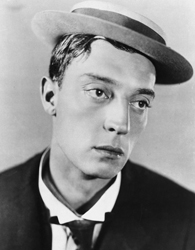One of the biggest stars of the silent film era, actor and director Buster Keaton revolutionized the art of physical comedy. From a childhood spent on the vaudeville stage to besting a struggle with alcoholism, Keaton always found a way to come out on top.
Buster Keaton’s Early Days
Although he was born Joseph Frank Keaton on October 4, 1895, Buster didn’t keep the name for long. “[T]he show I was born with was called the ‘Harry Houdini and Keaton Medicine Show Company,’” Keaton told an interviewer in 1958. “That was the great Harry Houdini, the handcuff king. That’s how he started out. And he gave me the name of Buster.”
By the time he was five years old, Keaton’s vaudevillian parents turned his aptitude for surviving a fall unharmed into a starring act, “The Three Keatons.” The littlest Keaton, Buster, wearing a fright wig, fake beard and oversized shoes would play his father’s foil, bringing down the house with extreme physical stunts. On an average evening, Keaton would be chased with a broom, hit over the head and thrown off stage into an orchestra pit, all by his father.
At times, the audience seemed shocked by such brute behavior toward one so young. So Keaton took to keeping a deadpan face, which not only soothed worries about abuse, but also delighted onlookers with its juxtaposition to the action. After his father’s alcoholism led him to increasingly real violence against his son, Keaton quit the vaudeville act for Broadway, where he was immediately given a starring role.
Sources in this Story
- Columbia University: Reminisces of Joseph Frank (Buster) Keaton
- The International Buster Keaton Society
- Time Magazine: The Fatty Arbuckle Scandal
- IMDb: Buster Keaton
- PBS American Masters: Buster Keaton
- YouTube: Buster Keaton performing stunts in “The General”
- Buster Keaton Celebration
Keaton’s Notable Accomplishments
After two months on Broadway, Keaton broke his contract after being introduced to film comic Roscoe “Fatty” Arbuckle, who landed him a role the same day they met. Keaton’s scene in “The Butcher Boy” was shot in one take, but instead of taking the offered starring role, he signed on as a camera man with a supporting part so he could learn the technology behind making films.
Arbuckle and Keaton became fast friends, with Keaton serving as Arbuckle’s assistant director, actor, writer and gagman in more than 15 movies, from 1917 to 1920. His success was so great that he was given his own production company in 1920. Over the next eight years he made 19 short films and 12 feature-length productions, most of which were acclaimed by the critics.
The deadpan face Keaton had perfected as a boy served him well through these films. He was known for his “stone face,” because he remained impassive and solemn in a film world full of exaggeration. In comedies, audiences loved the dry humor of his plain face and in more dramatic roles they were sympathetic to the heavy-lidded eyes and firmly set expression. But more than his face, Keaton’s fans loved his stunts.
His love for machinery led Keaton to center many stunts on trains or automobiles, and his death-defying exploits—such as straddling a moving locomotive’s cattle-catcher, or jumping from standing into a moving car—delighted as well as shocked.
Keaton’s signature porkpie hat, oversized “slapshoes” and dry humor were just a few of his contributions to the legacy of slapstick comedy. Although his films never won awards, some, such as 1926’s “The General,” and the 1924 comedy “Sherlock Jr.” are still loved today as the some of best silent films ever made.
Buster Keaton and his Work
- Buster Keaton–65th Anniversary Collection (DVD)
- The General (DVD)
- Our Hospitality (DVD)
- The Best Arbuckle/Keaton Collection
The Rest of the Story
After a meteoric rise to success, Keaton suffered a nearly equal fall. According to PBS, once films included dialogue, he “no longer possessed the stoic charm many had grown to love.” He had to take an uncredited writing job, and began drinking heavily. But an appearance in Charlie Chaplin’s 1953 movie “Limelight” helped him rebuild his career. He started appearing on television, and his films returned to the theater. He died in 1966 from complications of lung cancer. He is remembered every year through a celebration in his birth state of Kansas.
This article was originally written by Jennifer Ferris; it was updated October 10, 2017.











